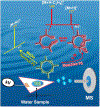Emerging trends in paper spray mass spectrometry: Microsampling, storage, direct analysis, and applications
- PMID: 31491055
- PMCID: PMC7875099
- DOI: 10.1002/mas.21601
Emerging trends in paper spray mass spectrometry: Microsampling, storage, direct analysis, and applications
Abstract
Recent advancements in the sensitivity of chemical instrumentation have led to increased interest in the use of microsamples for translational and biomedical research. Paper substrates are by far the most widely used media for biofluid collection, and mass spectrometry is the preferred method of analysis of the resultant dried blood spot (DBS) samples. Although there have been a variety of review papers published on DBS, there has been no attempt to unify the century old DBS methodology with modern applications utilizing modified paper and paper-based microfluidics for sampling, storage, processing, and analysis. This critical review will discuss how mass spectrometry has expanded the utility of paper substrates from sample collection and storage, to direct complex mixture analysis to on-surface reaction monitoring.
Keywords: ambient ionization; direct analysis; direct reaction monitoring by paper spray; dried blood spot (DBS); mass spectrometry; microfluidic devices; microsampling; paper spray (PS); solid-phase extraction.
© 2019 John Wiley & Sons Ltd.
Figures
















Similar articles
-
The use of mass spectrometry to analyze dried blood spots.Mass Spectrom Rev. 2016 May-Jun;35(3):361-438. doi: 10.1002/mas.21441. Epub 2014 Sep 22. Mass Spectrom Rev. 2016. PMID: 25252132 Review.
-
Comparison of paper spray mass spectrometry analysis of dried blood spots from devices used for in-field collection of clinical samples.Anal Bioanal Chem. 2017 Jan;409(1):121-131. doi: 10.1007/s00216-016-9954-5. Epub 2016 Nov 7. Anal Bioanal Chem. 2017. PMID: 27822645
-
Microsampling with cotton thread: Storage and ultra-sensitive analysis by thread spray mass Spectrometry.Anal Chim Acta. 2019 Nov 15;1082:98-105. doi: 10.1016/j.aca.2019.07.015. Epub 2019 Jul 9. Anal Chim Acta. 2019. PMID: 31472717 Free PMC article.
-
Challenges and opportunities in blood flow through porous substrate: A design and interface perspective of dried blood spot.J Pharm Biomed Anal. 2019 Oct 25;175:112772. doi: 10.1016/j.jpba.2019.07.020. Epub 2019 Jul 21. J Pharm Biomed Anal. 2019. PMID: 31362248 Review.
-
Direct analysis from dried blood spot card surfaces with direct probe mass spectrometry - Evaluation study.Rapid Commun Mass Spectrom. 2019 Jul 15;33(13):1148-1152. doi: 10.1002/rcm.8447. Rapid Commun Mass Spectrom. 2019. PMID: 30919500
Cited by
-
Reactive Thread Spray Mass Spectrometry for Localization of C═C Bonds in Free Fatty Acids: Applications for Obesity Diagnosis.Anal Chem. 2022 Feb 8;94(5):2358-2365. doi: 10.1021/acs.analchem.1c03270. Epub 2022 Jan 24. Anal Chem. 2022. PMID: 35072466 Free PMC article.
-
Accelerated nucleophilic substitution reactions of dansyl chloride with aniline under ambient conditions via dual-tip reactive paper spray.Sci Rep. 2020 Dec 9;10(1):21504. doi: 10.1038/s41598-020-78133-4. Sci Rep. 2020. PMID: 33299034 Free PMC article.
-
Biological Fluid Microsampling for Therapeutic Drug Monitoring: A Narrative Review.Biomedicines. 2023 Jul 12;11(7):1962. doi: 10.3390/biomedicines11071962. Biomedicines. 2023. PMID: 37509602 Free PMC article. Review.
-
Direct differentiation of whole blood for forensic serology analysis by thread spray mass spectrometry.Analyst. 2020 Aug 21;145(16):5615-5623. doi: 10.1039/d0an00857e. Epub 2020 Jul 7. Analyst. 2020. PMID: 32633747 Free PMC article.
-
Automated Immunoassay Performed on a 3D Microfluidic Paper-Based Device for Malaria Detection by Ambient Mass Spectrometry.Anal Chem. 2022 Mar 29;94(12):5132-5139. doi: 10.1021/acs.analchem.1c05530. Epub 2022 Mar 16. Anal Chem. 2022. PMID: 35293204 Free PMC article.
References
-
- Adam BW, Alexander JR, Smith SJ, Chace DH, Loeber JG, Elvers LH, and Hannon WH 2000. Recoveries of Phenylalanine from Two Sets of Dried-Blood Spot Reference Materials: Predition from Hematocrit, Spot Volume, and Paper Matrix. Clinical Chemistry. 46:126–128. - PubMed
-
- Alberici RM, Simas RC, Sanvido GB, Romão W, Lalli PM, Benassi M, Cunha IBS, and Eberlin MN 2010. Ambient mass spectrometry: bringing MS into the “real world.” Anal Bioanal Chem. 398:265–294. - PubMed
-
- Alfazil AA, and Anderson RA 2008. Stability of Benzodiazepines and Cocaine in Blood Spots Stored on Filter Paper. Journal of Analytical Toxicology. 32:511–515. - PubMed
-
- Aliaga-Aguilar H 2018. Characterization and Analysis of Paper Spray Ionization of Organic Compounds. Journal of The American Society for Mass Spectrometry. 29:17–25. - PubMed
Publication types
MeSH terms
Grants and funding
LinkOut - more resources
Full Text Sources
Other Literature Sources

